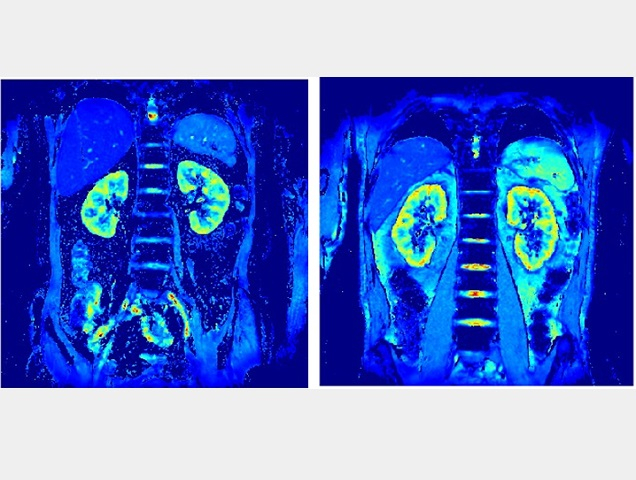Research News
Nov 18, 2024
- Medicine
Diabetes drug shows promise in protecting kidneys
SGLT2 inhibitor canagliflozin helps oxygenate kidneys while causing glucose removal through urine
BOLD MRI focusing on the kidneys
More red areas in the kidney indicate higher oxygen levels.
Credit: Osaka Metropolitan University

Type 2 diabetes can lead to diabetic kidney disease, but a class of drugs that cause the kidneys to remove glucose through urine has been gaining attention. An Osaka Metropolitan University-led research group has investigated how such drugs maintain kidney health.
Known as SGLT2 (sodium-glucose cotransporter-2) inhibitors, the drugs are used to treat type 2 diabetes along with an exercise and diet regimen. The group led by Graduate School of Medicine Associate Professor Katsuhito Mori focused on the SGLT2 inhibitor canagliflozin and its effects on the kidney.
Using BOLD (blood oxygenation level-dependent) MRI, a method used to see changes in blood oxygen flow in the brain to monitor activity, the group found that patients on canagliflozin for five days showed more oxygen in their kidneys the first day after administration of the drug. The researchers believe this indicates that SGLT2 inhibitors might improve the oxygenation of the kidneys, thereby protecting the organs.
“In animal experiments, the amount of oxygen in the kidneys can be measured by inserting a microelectrode, but this is not possible in humans,” Professor Mori explained. “BOLD MRI can measure kidney oxygenation non-invasively, and this is expected to become an important technology for elucidating the mechanisms of kidney disease for the development of therapeutic drugs.”
The findings were published in Frontiers in Endocrinology.
Funding
This study was supported by Mitsubishi Tanabe Pharma Corporation.
Paper information
Journal: Frontiers in Endocrinology
Title: Effects of canagliflozin on kidney oxygenation evaluated using blood oxygenation level-dependent MRI in patients with type 2 diabetes
DOI: 10.3389/fendo.2024.1451671
Authors: Katsuhito Mori, Tsutomu Inoue, Yuri Machiba, Hideki Uedono, Shinya Nakatani, Masahiro Ishikawa, Satsuki Taniuchi, Yutaka Katayama, Akira Yamamoto, Naoki Kobayashi, Eito Kozawa, Taro Shimono, Yukio Miki, Hirokazu Okada, Masanori Emoto
Published: 30 August 2024
URL: https://doi.org/10.3389/fendo.2024.1451671
Contact
Graduate School of Medicine
Email: ktmori[at]omu.ac.jp
*Please change [at] to @.
SDGs
